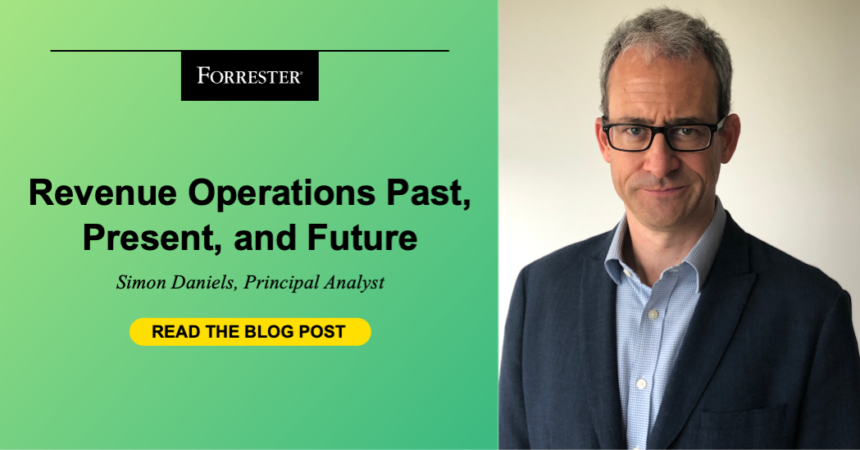I recently enjoyed my annual trip to see Charles Dickens’ “A Christmas Carol” at London’s Old Vic Theatre, where every year the production features a different actor playing Scrooge (this year, it was former “Doctor Who” Christopher Eccleston!). The timeless tale of redemption and second chances, of course, depicts miserly Ebenezer Scrooge as he is visited by three spirits who show him the true meaning of Christmas. This got me thinking about the evolution of revenue operations and where it’s heading. As practitioners, we haven’t always gotten everything right, so can we be saved?!
RevOps Past
Things weren’t always as they are now:
- It’s actually not necessary to go very far into the past to find a point when there was nobody doing operations in sales or marketing at all. Times were admittedly simpler, yet this meant that individual marketers were having to wrap their heads around data, systems, and processes on top of everything else on their plates. The fortunate ones might have had a colleague handling “database marketing,” so at least that aspect was covered!
- Back when the pinnacle of home automation was the clicker, the marketing-qualified lead was invented. Representing a single individual at a point in time, it was the unit of measurement for marketing demand generation. This, though, overlooked that B2B purchases are generally made by groups of people over the course of multiple interactions.
- Having generated a lead, marketing diligently recorded its source and sought to track it all the way to a final purchase. Again, though, this doesn’t account for the multiplicity of leads and interactions that contribute to a final deal. And what about existing customers in retention or expansion motions who marketing is assisting? The source is even further in the past, and what matters is the ultimate value that is added.
- That database marketing manager, where they existed, would have been working hard to build the biggest possible contact database for direct marketing activity of some kind. Less effort would go into maintaining it or thinking about what should happen when the data expired — certainly no need to worry about whether those people actually wanted to receive these messages!
- There was much less technology back then, of course, perhaps just a database and maybe an email system of some kind. It might have been managed by IT, which was awkward, because they didn’t really understand the business requirements or put much priority on it. Marketing and sales likely had separate, unconnected systems, making a single view of prospects and customers next to impossible.
RevOps Present
Needless to say, the situation is much improved now:
- In the 2000s, the concept of sales and then marketing operations was adopted by more forward-thinking businesses. Comprising teams dedicated to some combination of data, technology, process, measurement, and skills, these specialists developed expertise and enabled frontline marketers to stay focused. Unfortunately, these teams have the tendency to be rather siloed and less aligned than they should be.
- Advances in technology have seen the development of CRM and the introduction of marketing automation, bringing the ability to more easily score and group leads together for more effective demand management. Scoring leads individually, though, still overlooks the value of a buying group in combination, and valuable demand remains as signals that are overlooked or left behind.
- Recognizing the contribution that they make beyond just directly sourced leads, marketers now employ “influenced” metrics to measure revenue that has been touched by marketing. This still relies on granular and at times arbitrary association between marketing outcomes and deals. At least all of this is captured on readily accessible CMO dashboards, along with a variety of other metrics for quick reference.
- A growing plethora of privacy legislation obliges marketers to take a much less nonchalant approach to personal data management and privacy. Considerations around the cost of maintaining large databases also forces greater discipline over what personal data is captured and stored. Marketers now pay much greater attention to first- and zero-party-sourced data, deliberately provided by individuals looking to engage with brands.
- Technology options have exploded, with a tool for every conceivable task and use case. This has led to overenthusiastic adoption in some cases, though, with duplicate and redundant tools creating bloated tech stacks that are hard to manage and cost more than necessary. Inadequate integration from one end of the revenue ecosystem to the other also contributes to alignment issues and negatively impacts customer experience.
RevOps Future
In the future, revenue operations will be all about closing the customer value gap and driving commercial performance:
- Businesses increasingly recognize the benefit of operations aligning across the revenue ecosystem. While this doesn’t necessarily mean creating a single, centralized revenue operations function, it points to a commercial execution strategy designed to maximize customer value and commercial performance. This is achieved by unifying and optimizing data, processes, technology, and talent to better serve the customer lifecycle.
- Opportunity-based and buying-group-oriented demand management, as embodied by the Forrester B2B Revenue Waterfall, is now fully embraced. The idea of measuring demand generation by individual leads, with the associated wildly inaccurate metrics and extreme failure rates, is looked on with quaint amusement. Similarly, no expression of demand is considered complete without a core buying group having been identified and evaluated before being passed to sales.
- Alongside the Revenue Waterfall demand model, marketing measurement is entirely focused on the overall impact of demand generation activity. This now means that the full impact of marketing, across new business, retention, and expansion, is taken into account, regardless of the original source of a particular piece of business.
- In Forrester’s Q1 2023 Global B2B Intent Data Survey, over 85% of companies using intent data were found to have achieved business benefits. Now this total is closing on 100%, as companies realize the competitive disadvantage of not having visibility of prospective purchasers in their market. The ability to work with innovative providers of intent data and readily incorporate it into operational systems and processes means that this source of insight is a routine measure for RevOps professionals.
- The importance of ensuring an integrated technology environment across the revenue ecosystem has been well understood for some time. This customer-centric approach to revenue technology acquisition and deployment ensures operational efficiency and cost-effectiveness and guards against tech debt further in the future. And needless to say, artificial intelligence is in use in every aspect of marketing.
***
Unlike Scrooge, there’s no need to be visited by ghoulish apparitions to know what we need to do to drive customer value throughout the revenue ecosystem. Forrester clients can speak to an analyst about any of the topics mentioned, and if you’re not yet a client, perhaps put Forrester Decisions on your wish list for Santa this year so you, too, can embrace the future of revenue operations. And that’s no humbug!
Happy Holidays!









